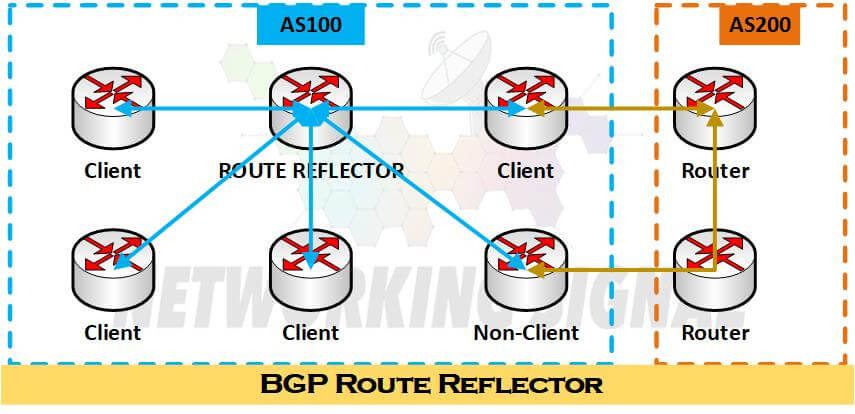What is BGP Route Reflector?
BGP Route Reflector is a feature in the Border Gateway Protocol (BGP) that allows BGP routers to exchange routing information without having to establish peer-to-peer sessions. This reduces the number of BGP sessions that need to be established, which can save on CPU and memory resources.
Why We Do Use BGP Route Reflector?
BGP Route Reflector is especially useful in large BGP networks, where there may be hundreds or even thousands of BGP routers. By using the BGP Route Reflector, the number of BGP sessions can be reduced to a manageable level.
If you are running a large BGP network, or if you are considering implementing BGP Route Reflector, there are a few things you should keep in mind.
- BGP Route Reflector is not a silver bullet. It will not solve all your BGP problems. In fact, it can sometimes make things worse.
- BGP Route Reflector is best used in conjunction with other BGP features, such as route filtering and prefix lists.
- BGP Route Reflector is not a replacement for good network design. A well-designed BGP network will still outperform a poorly designed one, even with BGP Route Reflector.
Benefits of BGP Route Reflector
Here are some of the benefits of using BGP Route Reflector:
- Reduced number of BGP sessions
- Lower CPU and memory usage
- Easier to manage large BGP networks
- Can improve network performance
How to Check Route Reflector in BGP?
The best way to check if BGP Route Reflector is working as expected is to use a tool like BGPMon. BGPMon is a free, open-source tool that allows you to monitor BGP routes in real-time.
If you see unexpected changes in your BGP routing table, or if you see routes disappearing or appearing, you can use BGPMon to investigate the cause.
How to Configure Route Reflector in BGP?

Here are the steps to configure BGP Route Reflector:
- Configure the route reflector cluster-ID. This is a unique identifier for your route reflector cluster.
- Configure the route reflector client. A route reflector client is a BGP router that will send its routes to the route reflector.
- Configure the route reflector. The route reflector is the BGP router that will receive routes from the route reflector clients and reflect them back to the other clients.
- Configure your BGP network. The final step is to configure your BGP network as usual. This includes specifying the AS number, BGP router ID, and other BGP parameters.
Example:
RouterA(config)# bgp cluster-id 100
RouterA(config)# bgp client-to-client reflection
RouterB(config)# bgp cluster-id 100
RouterB(config)# bgp client-to-client reflection
RouterC(config)# bgp cluster-id 100
RouterC(config)# bgp client-to-client reflection
In the example above, we have configured three BGP routers RouterA, RouterB, and RouterC to use BGP Route Reflector. We have also assigned a unique cluster ID of 100 to all three routers.
Now, when a route reflector client says RouterA sends its routes to the route reflector RouterB those routes will be reflected back to all the other clients, including RouterA.
Use case of BGP Route Reflector
Here are some use cases of BGP route reflectors that can be helpful for your understanding.
BGP route reflectors are commonly used in service provider networks. By using a route reflector, service providers can confine the IBGP full mesh requirement to a small set of route reflector clients and servers. This results in a significant reduction in the IBGP meshing requirements and the number of TCP sessions that must be maintained.
BGP route reflectors can also be used in enterprise networks.
- For example, an enterprise may have a main office and several remote offices. The main office may be configured as a route reflector server, while the remote offices are configured as route reflector clients. This allows the enterprise to maintain a full IBGP mesh only between the route reflector server and clients, while still allowing all remote offices to exchange routing information.
BGP route reflectors can also be used in small networks where it is not practical to configure a full IBGP mesh. In this case, the route reflector can be used to confine the IBGP full mesh requirement to a single router.

